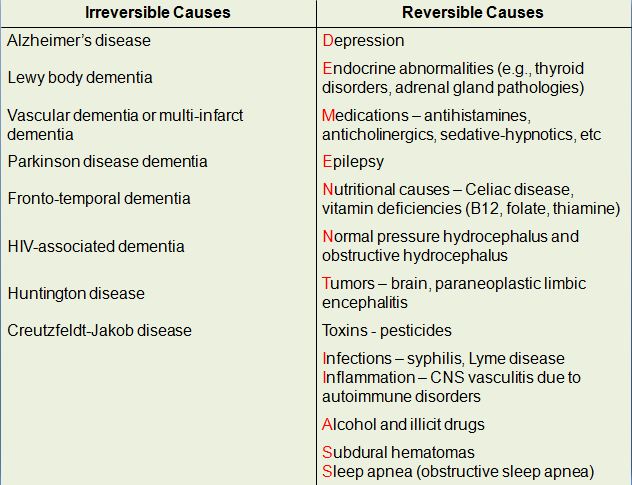WBR0891
Jump to navigation
Jump to search
| Author | [[PageAuthor::Ayokunle Olubaniyi, M.B,B.S [1]]] |
|---|---|
| Exam Type | ExamType::USMLE Step 2 CK |
| Main Category | MainCategory::Internal medicine |
| Sub Category | SubCategory::Neurology, SubCategory::Psychiatry |
| Prompt | [[Prompt::An 87-year-old man with a past medical history of hypothyroidism, mild hypertension and osteoarthritis is brought to the outpatient clinic by his son because of “increasing forgetfulness” for the past two years and it has been progressively getting worse. His medications are simvastatin, hydrochlorothiazide and L-thyroxine. He claims to be regular on his medications. He denies any history of fever, headache, or trauma. Mini-mental state examination (MMSE) reveals a score of 21/30. A neurologic examination is notable for impaired short-term recall, but motor and sensory functioning are intact with no ataxia and a negative Romberg’s sign. CT scan of the head shows mild cerebral atrophy.
Which of the following is an example of a reversible cause of this patient’s diagnosis?]] |
| Answer A | AnswerA::Alzheimer’s disease |
| Answer A Explanation | AnswerAExp::This is an irreversible cause of dementia. |
| Answer B | AnswerB::Lewy body dementia |
| Answer B Explanation | AnswerBExp::This is an irreversible cause |
| Answer C | AnswerC::Normal pressure hydrocephalus |
| Answer C Explanation | [[AnswerCExp::Normal pressure hydrocephalus (NPH) is a chronic type of communicating hydrocephalus whereby the increase in intracranial pressure (ICP) due to accumulation of cerebrospinal fluid (CSF) becomes stable and the formation of CSF equilibrates with absorption. The ICP gradually falls but still maintains a slightly elevated level and the CSF pressure reaches a high normal level of 150 to 200 mmH2O. Because of this equilibration, patients do not exhibit the classic signs of increased intracranial pressure such as headache, nausea, vomiting, or altered consciousness. It is often misdiagnosed as Parkinson's disease, Alzheimer's disease, and senility due to its chronic nature and its presenting symptoms. Typical symptoms include:
This is a reversible cause of dementia.]] |
| Answer D | AnswerD::Fronto-temporal dementia |
| Answer D Explanation | [[AnswerDExp::Frontotemporal lobar degeneration (FTLD) or Picks disease is a pathologic process involving degeneration of gray matter in the frontal lobe and anterior portion of the temporal lobe of the cerebrum, with sparing of the parietal and occipital lobes. Symptoms include: Parkinsonism with dystonia, dementia, urinary incontinence, neck stiffness, memory loss. This is an irreversible cause of dementia.]] |
| Answer E | AnswerE::HIV-associated dementia |
| Answer E Explanation | [[AnswerEExp::HIV-associated dementia, a.k.a. Aids Dementia Complex (ADC) is a metabolic encephalopathy induced by HIV infection and fueled by immune activation of brain macrophages and microglia. These cells are actively infected with HIV and secrete neurotoxins of both host and viral origin. The essential features are disabling cognitive impairment accompanied by motor dysfunction, speech problems and behavioral change. Cognitive impairment is characterized by mental slowness, trouble with memory and poor concentration. Motor symptoms include a loss of fine motor control leading to clumsiness, poor balance and tremors. Behavioral changes may include apathy, lethargy and diminished emotional responses and spontaneity. Histopathologically, it is identified by the infiltration of monocytes and macrophages into the central nervous system (CNS), gliosis, pallor of myelin sheaths, abnormalities of dendritic processes and neuronal apoptosis. ADC typically occurs after years of HIV infection and is associated with low CD4+ T cell levels and high plasma viral loads. It is sometimes seen as the first sign of the onset of AIDS. HAART may not only prevent or delay the onset of ADC in people with HIV infection; it can also improve mental function in people who already have ADC.
This is an example of an irreversible cause of dementia.]] |
| Right Answer | RightAnswer::C |
| Explanation | [[Explanation::According to the Statistical Manual of Mental Disorders, dementia is defined as a syndrome due to disease of the brain, usually of a chronic or progressive nature, in which there is disturbance of multiple higher cortical functions, including memory, thinking, orientation, comprehension, calculation, learning capacity, language, and judgment. Consciousness is not clouded.
The essential feature of dementia is impairment in short- and long-term memory, associated with impairment in abstract thinking, impaired judgment, other disturbances of higher cortical function, or personality change. The disturbance is severe enough to interfere significantly with work or usual social activities or relationships with others. The causes of dementia can be classified as reversible and irreversible. They are shown in table below: |
| Approved | Approved::No |
| Keyword | WBRKeyword::Normal pressure hydrocephalus, WBRKeyword::Dementia |
| Linked Question | Linked:: |
| Order in Linked Questions | LinkedOrder:: |
